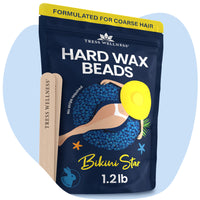Struggling with ingrown armpit hair? You’re not alone. Here’s how to get rid of ingrown armpit hair using effective home remedies, over-the-counter solutions, and professional treatments. This guide will help you soothe irritation and prevent future ingrown hairs.
Key Takeaways
-
Ingrown armpit hair occurs when hair grows back into the skin after removal, often caused by improper shaving techniques or clogged hair follicles.
-
Home remedies like regular exfoliation, warm compresses, and sterile needle techniques can help manage and prevent ingrown hairs.
-
Preventing ingrown hairs involves switching hair removal methods, using proper shaving techniques, and maintaining good hygiene for healthier skin.
Understanding Ingrown Armpit Hair

An ingrown hair is a hair that grows back into the skin instead of rising up from it. Ingrown armpit hair occurs when the hair curls back or grows sideways into the skin as it grows back after hair removal. This can happen because of various reasons, but it is most frequently seen after shaving, tweezing, or waxing. Ingrown hairs are essentially a result of our hair removal habits.
Incorrect shaving techniques, clogged hair follicles, and tight clothing that irritates the skin commonly cause ingrown hairs. Shaving or waxing improperly can make hair curve back into the skin. Thick or curly hair is more prone to becoming ingrown because it tends to curl back into the skin more easily.
Symptoms of ingrown armpit hair include red bumps, itching, and discomfort in the affected area. These ingrown hair bumps can become painful and are often worsened by sweat and deodorants. Recognizing these symptoms and their causes is the first step in managing and preventing ingrown hairs effectively.
Home Remedies for Ingrown Armpit Hair

Managing ingrown armpit hair at home can be effective with the right approach. Simple remedies can treat and prevent these pesky hairs. Regular washing and gentle scrubbing of the armpit area help keep the skin clean and free from dead skin cells, which can clog hair follicles and cause ingrown hairs.
Effective home remedies include regular exfoliation, using a warm compress, and carefully using a sterile needle to free trapped hairs. Each method tackles the problem from a different angle and can be easily incorporated into your routine.
Exfoliate Regularly
Exfoliation is vital for preventing ingrown hairs. Regular exfoliation helps lift hairs that might be starting to grow inward, preventing them from becoming ingrown. Using an exfoliating scrub or brush removes dead skin cells, which often clog hair follicles and trap hairs underneath the skin.
Gently exfoliating the armpit area with a scrub or brush prevents ingrown hairs and keeps the skin healthy and smooth. Exfoliate at least twice a week, and always follow up with a moisturizer to keep the skin hydrated and supple.
Warm Compress
A warm compress is another effective remedy for ingrown armpit hair. Applying a warm cloth to the area for 10 to 15 minutes can soften the skin and make it easier for trapped hairs to be released. The warmth helps open up the hair follicles, allowing hairs to emerge more easily.
Soak a cloth in warm water, wring out the excess, and apply it to the area. Repeat this process several times a day to help release ingrown hairs and reduce swelling and discomfort.
Over-the-Counter Treatments

If home remedies aren’t providing enough relief, over-the-counter treatments can help. Various medicated lotions and creams treat the inflammation and irritation associated with ingrown hairs. Look for products containing soothing ingredients like aloe vera and chamomile to reduce redness and discomfort.
Other effective over-the-counter options include chemical depilatories and electric razors. These methods decrease the likelihood of ingrown hairs by avoiding the close shaves that often lead to hairs curling back into the skin. Follow the instructions on the product and perform a patch test to ensure it doesn’t irritate your skin.
Professional Treatments
For more permanent solutions, professional treatments like laser hair removal and electrolysis are worth considering. Laser hair removal emits concentrated light absorbed by the pigment in the hair, resulting in reduced hair growth. This method provides long-lasting results and significantly reduces the occurrence of ingrown hairs.
Electrolysis targets individual hair follicles and offers a permanent solution by preventing hair regrowth. Both treatments are effective but require multiple sessions and a higher initial investment. Consulting with a dermatologist can help determine which treatment best suits your needs.
Preventing Ingrown Armpit Hair
Prevention is always better than cure, and this holds true for ingrown armpit hair. Adopting the right hair removal habits and maintaining good hygiene significantly reduces the risk of developing ingrown hairs. Several strategies can help keep those pesky hairs at bay.
Switching hair removal methods, using proper shaving techniques, and maintaining good hygiene are all effective ways to prevent ingrown hairs. Each method addresses different aspects of removing hair and skincare, making them comprehensive preventative measures.
Switch to Waxing

Switching from shaving to other hair removal methods like waxing or using depilatory creams is effective in preventing ingrown hairs. Waxing removes hair from the root, leading to finer hair regrowth and reducing the risk of ingrown hairs. Tress Wellness hard wax is perfect for your sensitive underarm skin.
Opting for these alternatives provides longer-lasting results and less frequent irritation. Choose a method that suits your skin type and hair texture for the best results.
Proper Shaving Techniques
If you prefer shaving, using proper techniques makes a big difference. Always use a sharp single-blade razor and shave in the direction of hair growth to reduce the likelihood of ingrown hairs. Washing the skin with warm water and a mild cleanser before shaving helps open up hair follicles and makes shaving smoother.
Avoid stretching the skin while shaving and limit the number of passes over the same area to prevent irritation to the surrounding skin. Applying a soothing after-shave product can help alleviate post-shave discomfort and promote healing.
Maintain Good Hygiene
Good hygiene plays a crucial role in preventing ingrown hairs. Here are some tips to maintain good hygiene and reduce the risk of ingrown hairs:
-
Keep the armpit area clean and well-moisturized to prevent dead skin cells from clogging hair follicles.
-
Regularly wash the area to remove dirt and sweat.
-
Exfoliate the skin to help remove dead skin cells and promote healthy skin.
By following these practices, you can reduce the risk of develop ingrown hairs and keep your skin healthy.
Moisturizing the skin after hair removal maintains its elasticity and prevents dryness, which can lead to irritation and ingrown hairs. Practicing good hygiene also helps prevent infections associated with ingrown hairs.
Complications of Untreated Ingrown Armpit Hair
Leaving ingrown hairs untreated can lead to complications. Infected ingrown hairs can become hard, painful, and filled with pus, requiring careful treatment. If the infection spreads, it can cause significant pain and swelling in the surrounding area.
Chronic inflammation and persistent ingrown hairs can lead to permanent skin damage, including scarring and skin discoloration. In severe cases, untreated ingrown hairs may develop into cysts or cause secondary infections. Addressing ingrown hairs promptly helps avoid these complications and keeps your skin healthy.
When to See a Doctor
While most ingrown hairs can be managed at home, there are times when you should seek medical advice. If the area around an ingrown hair appears hot, swollen, or if you experience fever, consult a doctor. These can be signs of a secondary infection that requires professional treatment.
If an ingrown hair does not go away or causes significant discomfort, seeing a doctor can help determine the safest and most effective treatment. A healthcare professional can also perform a swab test to identify any infections and recommend appropriate medications.
Summary
In summary, ingrown armpit hair can be a troublesome issue, but with the right knowledge and practices, it is manageable. Understanding the causes and symptoms of ingrown hairs, along with effective home remedies and over-the-counter treatments, can help you deal with them effectively. Professional treatments and preventive measures are also valuable tools in your skincare arsenal.
By adopting proper hair removal techniques, maintaining good hygiene, and seeking medical advice when necessary, you can keep ingrown hairs at bay and enjoy smoother, healthier skin. Remember, prevention is key, and a little care goes a long way in managing ingrown armpit hair.
Frequently Asked Questions
What causes ingrown armpit hair?
Ingrown armpit hair happens when hair grows back into the skin instead of out, usually because of shaving, tweezing, or waxing. To avoid it, consider alternative hair removal methods or prep your skin better before shaving.
How can I prevent ingrown armpit hair?
To prevent ingrown armpit hair, focus on proper hair removal techniques and regular exfoliation. Keeping the area clean and considering alternatives like waxing can also help you stay smooth and comfortable.
What are the symptoms of ingrown armpit hair?
If you're dealing with ingrown armpit hair, expect red bumps, itching, and discomfort, which can be aggravated by sweat and deodorants. Keeping the area clean and moisturized can help ease the symptoms.
When should I see a doctor for ingrown armpit hair?
You should see a doctor if your ingrown armpit hair becomes hot, swollen, or if you develop a fever. If the discomfort persists or the area doesn't heal, don’t hesitate to seek medical advice.
What are the complications of untreated ingrown armpit hairs?
Untreated ingrown armpit hairs can lead to painful infections, swelling, and even pus-filled bumps. Over time, this can cause permanent skin damage and scarring, so it’s best to address them early.




